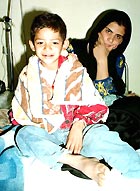
|
To investigate the effects of radioactive DU munitions, I visited the US, UK, Iraq, and Yugoslavia. I found serious health problems and environmental contamination resulting from the Gulf War, where they were first used, but also in the vicinity of US factories and firing ranges. Yet DU munitions continue to proliferate as "conventional weapons," and they will probably be used in future conflicts, as they were in Kosovo. To wrap up this series of articles, I will attempt to paint the bigger picture with respect to health problems and environmental contamination. Then, I will turn to the international movement to ban these weapons and the role to be played by Hiroshima residents who have suffered because of the A-bomb. (Story and photo by Akira Tashiro, senior
staff writer)
|
| Cancer increasing Experts concerned about the future |
Gulf War veterans in Iraq, the UK, and the
US are, despite their youth, plagued by a
high incidence and wide variety of physical
problems. Many children in Iraq fight day
to day a hopeless battle against leukemia
and other diseases. Workers in DU munitions
factories and residents in communities near
firing ranges struggle with anxiety about
the increasing cancers and other illnesses
around them.
![]() The painful sight of sick children
The painful sight of sick children
I often recall the faces of the many hibakusha (people exposed to radiation) I have interviewed around the world, but the innocent children in Iraq, dying for lack of medical equipment and medicine, hit me especially hard.
"We call this [the cancer ward] the Death Ward." These words from the chief resident (29) at Saddam Central Teaching Hospital in Baghdad express eloquently the staff's need to deal somehow with their inability to save their patients. A female doctor (32) at the Pediatric and Maternity Hospital in Basra, near the battlefield, was unable to hide her frustration. "We tell you foreign reporters about the situation over and over, but the economic sanctions are never lifted, and we are still unable to save our children."
The US Defense Department and the UK Defence Ministry, the ones who used DU munitions in the Gulf War, admit that their own troops were exposed, yet continue to deny the impact of what they have done. "The contamination is insufficient to affect health."
Vast numbers of veterans in both countries
are ill. Thousands have already died. It
may be wrong to blame all that on DU alone.
There are other factors, such as pyridostigmine
bromide (PB) taken as an antidote to chemical
weapons before being adequately tested. However,
that possibility does not eliminate the dangers
of DU. With the passage of time, it becomes
increasingly obvious that people do take
particles of uranium oxide into their bodies,
which expose them to internal radiation and
the chemical toxicity of this extremely heavy
metal.
![]() Damage extends to family members
Damage extends to family members
DU is still found in Gulf War veterans' urine nine years after exposure. The affects can be passed on to wives through intercourse, and to the unborn in the form of miscarriages and congenital defects. If they had just been informed of the dangers, they could have avoided passing their afflictions on to their families.
The Gulf War effects are most conspicuous
among American and British veterans, but
health problems continue to spread through
the rest of the multinational forces, including
those from Canada, France, and the former
Czechoslovakia.
![]() An additional 2000 soldiers suffering
An additional 2000 soldiers suffering
Suzanne Raidon (45), a Canadian who lost her husband Terry (45 when he died) in April 1999, lives in Yarmouth City, Nova Scotia.She spoke to me by phone. "Of the 4,500 Canadian soldiers that took part in the Gulf War, more than 2,000 have serious health problems."
Shortly after his return Terry experienced odd symptoms here and there until finally his whole body was wracked by pain. High levels of DU were found in his urine. Finally, saying, "If it'll prove that DU did this to me, I'll do it," he left a will donating his organs, bones and other tissues to an independent US research organization.
According to Suzanne, "Researchers found surprising levels of DU in his lungs, thyroid, bones and elsewhere." She is completely convinced that her husband was killed by DU.
Rosalie Bertell (71), who is president of the International Institute of Concern for Public Health in Toronto, Canada, and has for many years conducted epidemiological surveys of the health effects of low-level radiation from X-rays and other medical applications, offers this grim assessment. "Nine years have passed since the Gulf War. I assume the cancers will increase and the diseases of the veterans will become more serious."

An 8-year-old Iraqi boy fighting leukemia being cared for in the hospital by his mother. (Basra, Iraq)